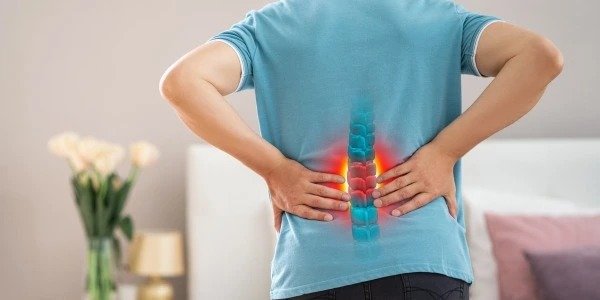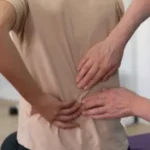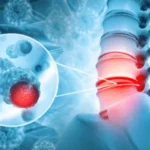What is a Slip Disc? Understanding the Condition
A slip disc, medically known as a herniated or prolapsed disc, it happens When the soft, The gel-like center of a spinal disc pushes out through a rupture in its outer shell crack in the tougher exterior layer disc between vertebrae ruptures or bulges out of place, potentially pressing on nearby nerves. The human spine is made up of 33 vertebrae, each separated by intervertebral discs that provide cushioning and flexibility; these discs, which act as shock absorbers and allow flexibility of the spine.

The human spine is structured into three primary regions:
- Cervical (neck) region – 7 vertebrae
- Thoracic (mid-back) region – 12 vertebrae
- Lumbar (lower back) region – 5 vertebrae
Slip discs most commonly occur in the lumbar region (lower back) and cervical region (neck), though they can happen anywhere along the spine. When a disc herniates, its inner gel-like substance The nucleus pulposus pushes out through a rupture in the outer layer though outer layer (annulus fibrosus), causing inflammation and pressure on surrounding nerves.
Slip Disc Causes: Why is India Seeing an Increase?
Understanding slip disc causes can help in preventing this painful condition. The rising prevalence of slip disc cases in India can be attributed to several factors:
Age-Related Degeneration
Natural aging processes lead to disc degeneration as Over time, spinal discs lose moisture and become less flexible. By age 30, many people already have some disc degeneration, though it may not cause symptoms. However, the condition becomes more common and severe with advancing age.
Lifestyle Factors
Modern Indian lifestyle has undergone significant changes that contribute to spinal problems:
- Sedentary Behavior: Extended periods of sitting, especially with poor posture, place excessive pressure on spinal discs. With increasing desk jobs and screen time, more Indians spend 8-10 hours daily in seated positions.
- Physical Inactivity: Lack of regular exercise leads to weak core muscles that normally help support the spine. Studies show that over 54% of urban Indians don’t get adequate physical activity.
- Improper Lifting Techniques: Lifting heavy objects incorrectly, particularly using back muscles instead of leg muscles, significantly increases the risk of disc herniation.
- Poor Ergonomics: Improper workstation setups and unsuitable furniture at home and office contribute to poor posture and spinal stress.
Occupational Hazards
Certain professions carry higher risks:
- Drivers (especially long-distance and commercial vehicle operators)
- Construction workers
- Factory workers involved in heavy lifting
- Healthcare workers who transfer patients
- IT professionals and office workers with prolonged sitting
Nutritional and Body Composition Factors
- Excess body weight adds extra pressure to the spine, especially the lower back spine, especially the lumbar region, increasing the risk of back problems. In India, obesity rates have doubled over the last ten years.
- Poor nutrition: Inadequate intake of calcium, vitamin D, and other nutrients essential for bone health affects disc integrity.
Genetic Predisposition
Certain individuals may be genetically inclined to develop the condition disc degeneration and herniation. Family history of spinal problems increases risk by 20-30%.
When looking for the best doctor for back pain in Delhi, it’s important to find someone who considers all these factors for proper diagnosis and treatment planning.
Recognizing Slip Disc Symptoms: Warning Signs You Shouldn’t Ignore
Common slip disc symptoms include radiating pain, numbness, and weakness in the affected area. The specific symptoms experienced depend largely on Depending on where the disc herniates and which nerves it compresses. Recognizing slip disc symptoms early can lead to more effective treatment and faster recovery.
Cervical (Neck) Slip Disc Symptoms
When a disc bulges or herniates in the cervical (neck) region, symptoms typically include:
- Neck pain that may be sharp or dull
- Pain radiating down the arm to the hand and fingers
- Numbness or tingling sensation in shoulders, arms, or hands
- Weakness in specific muscles of the arms, hands, or shoulders
- Headaches, particularly at the back of the head
- Challenges with precise hand movements, including writing or buttoning clothes shirts
Lumbar (Lower Back) Slip Disc Symptoms
Lumbar disc herniation, the most common type, usually presents with:
- Lower back pain that may be mild to severe
- Sciatica – pain radiating from the buttock down the leg, sometimes to the foot
- Loss of sensation or pins-and-needles feeling in the lower limbs
- Muscle weakness in legs or feet
- Difficulty walking or standing straight
- Pain that intensifies while sitting, bending, or lifting coughing
- In severe cases, bowel or bladder dysfunction (requires immediate medical attention)
Progression of Symptoms
Slip disc symptoms often follow a pattern:
- Initial Phase: Localized pain in the affected area
- Progression: Development of radiating pain along the path of the affected nerve
- Advanced Stage: Neurological symptoms like numbness, tingling, and muscle weakness
The best doctor for slip disc in Delhi will typically evaluate the pattern and progression of symptoms to determine the severity and appropriate treatment approach.
Modern Slip Disc Diagnosis: Accurate Assessment for Effective Treatment
Accurate slip disc diagnosis is essential for determining the most appropriate treatment approach. The diagnostic process has evolved significantly with advanced imaging technologies now available across major Indian cities, particularly in medical hubs like Delhi NCR.
Initial Clinical Evaluation
The process of slip disc diagnosis begins with An in-depth physical evaluation combined with a complete assessment of your medical history. This typically includes:
- Detailed History Taking: Information about pain onset, duration, aggravating and relieving factors, and previous treatments
- Physical Examination: Assessment of:
- Range of motion
- Muscle strength
- Reflexes
- Sensory function
- Targeted diagnostic methods like the straight leg raise test for lumbar disc herniation
Advanced Imaging Techniques
Modern slip disc diagnosis typically involves imaging tests such as MRI and CT scans. These may include:
- X-rays: While not showing discs directly, they can rule out other conditions like fractures or tumors
- Magnetic Resonance Imaging (MRI): The most reliable method for detailed assessment diagnosing disc herniation, showing High-resolution images that clearly show soft tissues such as spinal discs, nerves, and the spinal cord
- Computed Tomography (CT) Scan: Offers high-resolution cross-sectional images of the body’s internal structures bony structures and can be useful when MRI is contraindicated
- CT Myelogram: Involves injecting contrast dye before a CT scan used to enhance visibility of the spinal cord and surrounding structures nerve roots
- Electromyography (EMG): Detects and records the electrical signals produced by muscle activity to assess nerve and muscle function determine if nerve damage has occurred
Diagnostic Challenges in the Indian Context
While advanced diagnostic tools are available in major Indian cities, several challenges exist:
- Limited accessibility in rural areas
- Cost constraints for comprehensive imaging
- Delayed diagnosis due to initial self-medication
- Misdiagnosis of slip disc as general back pain
Sant Parmanand Hospital is recognized as the best slip disc hospital in Delhi with state-of-the-art diagnostic facilities that overcome these challenges, offering accurate and timely diagnosis.
Comprehensive Treatment Options for Slip Disc in India
Treatment approaches for slip disc range from conservative management to advanced surgical interventions. The suitable treatment is determined by the severity of the condition symptoms, duration of the problem, and the patient’s overall health status.
Conservative Management
For mild to moderate cases, non-surgical approaches are typically the first line of treatment:
- Rest and Activity Modification: Short-term rest (usually 1-2 days) followed by gradual return to activities while avoiding movements that aggravate pain
- Physical Therapy: Customized exercise programs to strengthen core and back muscles, improve flexibility, and correct posture
- Medications:
- Non-steroidal anti-inflammatory drugs (NSAIDs) for pain and inflammation
- Muscle relaxants for associated muscle spasms
- Nerve pain medications for radiating pain
- Epidural Steroid Injections: Corticosteroid injections around the affected nerve roots to reduce inflammation and pain
Minimally Invasive Procedures
When conservative treatments don’t provide adequate relief, minimally invasive procedures may be considered:
- Percutaneous Disc Decompression: Removal of disc material through a needle to relieve pressure
- Radiofrequency Ablation: Involves using heat produced by radio waves to target and disrupt nerve activity reduce pain signals from nerves
- Ozone Therapy: Injection of ozone gas into the disc to reduce inflammation and promote healing
Advanced Surgical Interventions
If treatments do not offer relief, surgery may become necessary severe cases or when other treatments prove ineffective, surgical options may be necessary:
- Microdiscectomy: A less invasive surgical technique used to extract the bulging part of a spinal disc causing pressure or pain herniated part of the disc through a small incision
- Endoscopic Discectomy: Using a small endoscope to visualize and remove the herniated disc material
- Artificial Disc Replacement: Entails substituting a damaged spinal disc with an artificial implant to restore function and mobility to preserve natural spinal movement
- Spinal Fusion: Joining two vertebrae together to provide stability after disc removal
When seeking treatment for severe slip disc conditions, consulting the best endoscopic spine surgeon in Delhi can significantly boost the probability of a successful result outcome.
Endoscopic Spine Surgery: The Gold Standard for Slip Disc Treatment
Endoscopic spine surgery represents the cutting edge of slip disc treatment, offering significant advantages over traditional open surgery. This minimally invasive approach has revolutionized spine surgery in India, with Delhi NCR emerging as a hub for this advanced technique.
What is Endoscopic Spine Surgery?
Endoscopic spine surgery involves making a tiny incision (usually less than 1 cm) and inserting a small tube with an attached camera (endoscope) to visualize the spine. Specialized instruments are then used through this tube to remove the herniated disc material without damaging surrounding tissues.
The Endoscopic Advantage
The endoscopic spine surgery benefits include faster recovery, minimal scarring, and reduced postoperative pain. Specific advantages include:
- Minimal Tissue Damage: Unlike traditional open surgery that requires cutting through muscles, endoscopic surgery gently pushes muscles aside
- Reduced Blood Loss: Typically less than 5-10 ml compared to 100-300 ml in open surgery
- Shorter Hospital Stay: Often performed as day surgery or requiring just 24 hours of hospitalization
- Faster Recovery: The majority of patients are able to resume normal activities within a short period 1-4 weeks versus 2-3 months for traditional surgery
- Lower Infection Risk: Smaller incisions mean reduced infection risk
- Minimal Postoperative Pain: Less tissue damage translates to less pain
- Better Cosmetic Results: Tiny scars that are barely visible
- Preservation of Spinal Stability: Maintains the natural biomechanics of the spine
Dr. Amit Shridhar is widely regarded as the best doctor for slip disc in Delhi due to his expertise in endoscopic procedures. His approach combines technical precision with patient-centered care, ensuring optimal outcomes for even complex cases.
Prevention and Management: Reducing Your Risk of Slip Disc
While treatment options have advanced significantly, prevention remains the best approach to slip disc problems. Incorporating these strategies can significantly reduce your risk:
Ergonomic Practices
- Workplace Ergonomics:
- Choose an ergonomic chair designed to support the natural alignment of your spine
- Position your computer monitor at eye level
- Keep your feet flat on the floor when sitting
- Take short breaks every 30 minutes to stand and stretch
- Proper Lifting Techniques:
- Bend at the knees, not the waist
- Keep the object close to your body
- Avoid twisting while lifting
- Get help for heavy items
Lifestyle Modifications
- Regular Exercise:
- Strengthen core muscles through targeted exercises
- Practice yoga or Pilates for flexibility and strength
- Maintain a consistent walking routine
- Swimming provides excellent low-impact exercise for the spine
- Weight Management:
- Maintain a healthy BMI to reduce pressure on the spine
- Maintain a well-balanced diet that includes ample calcium and vitamin D for bone health
- Stay hydrated to maintain disc health
- Posture Awareness:
- Pay attention to your posture consistently throughout the day
- Avoid slouching when standing or sitting
- Use lumbar support when sitting for long periods
- Sleep on a medium-firm mattress in a position that maintains spinal alignment
Early Intervention
If you experience persistent back pain or any slip disc symptoms, seeking early medical attention can prevent progression to more severe conditions. The best doctor for back pain in Delhi will typically recommend a thorough diagnostic process before suggesting treatment options.
Conclusion: Addressing the Slip Disc Epidemic in India
The growing prevalence of slip disc conditions in India represents a significant health challenge, particularly in urban centers like Delhi NCR. However, with increased awareness, preventive measures, and access to advanced treatment options, this epidemic can be effectively managed.
Understanding the causes, recognizing symptoms early, and seeking appropriate medical care are crucial steps in addressing slip disc problems. The evolution of treatment approaches, particularly minimally invasive techniques like endoscopic spine surgery, has transformed outcomes for patients, offering faster recovery and better quality of life.
Sant Parmanand Hospital, with its comprehensive spine care program and expert specialists, exemplifies the high standard of care now available in India. Patients seeking specialized treatment should consider the best slip disc hospital in Delhi for optimal outcomes.
If you’re experiencing back pain or symptoms suggestive of a slip disc, don’t delay seeking medical attention. Early diagnosis and appropriate treatment can play a crucial role in your recovery process and support you in achieving better outcomes and return to a pain-free, active lifestyle.
For residents of Delhi NCR and beyond, access to world-class spine care is now a reality, offering hope and healing for those affected by this increasingly common condition.



